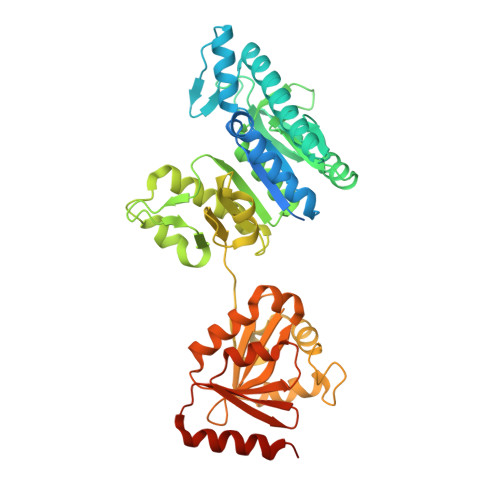Insight on an Arginine Synthesis Metabolon from the Tetrameric Structure of Yeast Acetylglutamate Kinase
De Cima, S., Gil-Ortiz, F., Crabeel, M., Fita, I., Rubio, V.(2012) PLoS One 7: 34734
- PubMed: 22529931
- DOI: https://doi.org/10.1371/journal.pone.0034734
- Primary Citation of Related Structures:
3ZZF, 3ZZG, 3ZZH, 3ZZI, 4AB7 - PubMed Abstract:
N-acetyl-L-glutamate kinase (NAGK) catalyzes the second, generally controlling, step of arginine biosynthesis. In yeasts, NAGK exists either alone or forming a metabolon with N-acetyl-L-glutamate synthase (NAGS), which catalyzes the first step and exists only within the metabolon. Yeast NAGK (yNAGK) has, in addition to the amino acid kinase (AAK) domain found in other NAGKs, a ~150-residue C-terminal domain of unclear significance belonging to the DUF619 domain family. We deleted this domain, proving that it stabilizes yNAGK, slows catalysis and modulates feed-back inhibition by arginine. We determined the crystal structures of both the DUF619 domain-lacking yNAGK, ligand-free as well as complexed with acetylglutamate or acetylglutamate and arginine, and of complete mature yNAGK. While all other known arginine-inhibitable NAGKs are doughnut-like hexameric trimers of dimers of AAK domains, yNAGK has as central structure a flat tetramer formed by two dimers of AAK domains. These dimers differ from canonical AAK dimers in the -110° rotation of one subunit with respect to the other. In the hexameric enzymes, an N-terminal extension, found in all arginine-inhibitable NAGKs, forms a protruding helix that interlaces the dimers. In yNAGK, however, it conforms a two-helix platform that mediates interdimeric interactions. Arginine appears to freeze an open inactive AAK domain conformation. In the complete yNAGK structure, two pairs of DUF619 domains flank the AAK domain tetramer, providing a mechanism for the DUF619 domain modulatory functions. The DUF619 domain exhibits the histone acetyltransferase fold, resembling the catalytic domain of bacterial NAGS. However, the putative acetyl CoA site is blocked, explaining the lack of NAGS activity of yNAGK. We conclude that the tetrameric architecture is an adaptation to metabolon formation and propose an organization for this metabolon, suggesting that yNAGK may be a good model also for yeast and human NAGSs.
Organizational Affiliation:
Instituto de Biomedicina de Valencia del Consejo Superior de Investigaciones Científicas, Centro de Investigación Biomédica en Red de Enfermedades Raras-ISCIII, Valencia, Spain.















